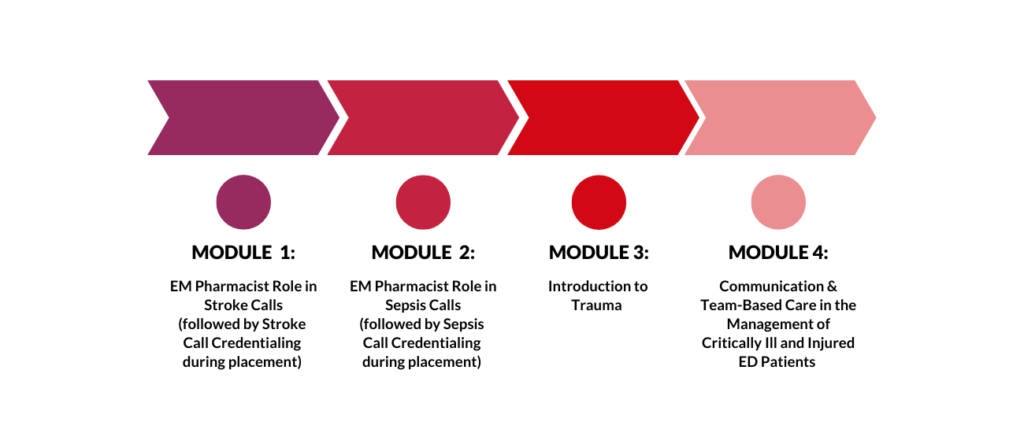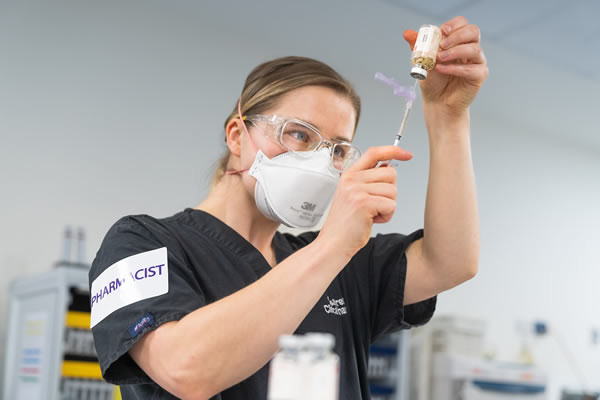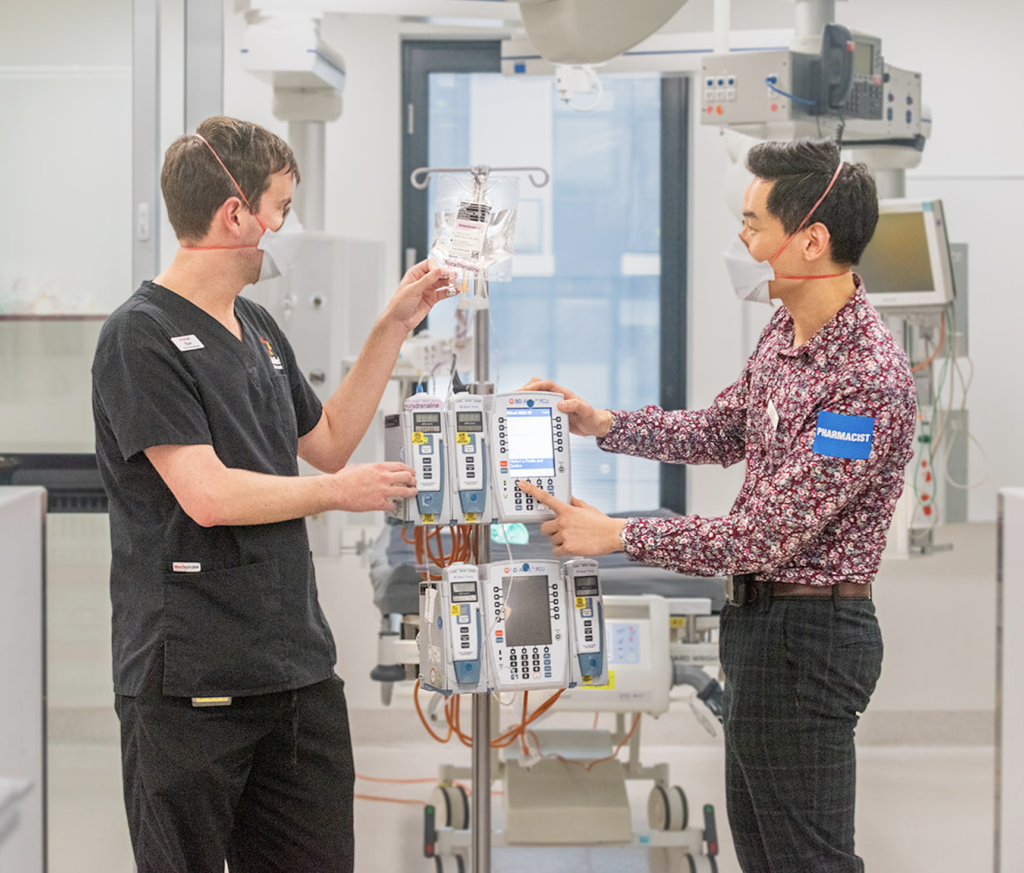Alfred Health’s Emergency & Trauma Centre (E&TC) is a quaternary referral centre providing several statewide services, including major trauma, burns and neurosurgery, as well as advanced lifesaving interventions such as extracorporeal cardiopulmonary resuscitation (ECPR). It is the busiest adult level one Trauma Centre in Australia.
Alfred Health’s team of specialised Emergency Medicine (EM) pharmacists are integral members of the E&TC multidisciplinary team, through the development and delivery of several evidence-based extended scope EM clinical pharmacist practices . Each EM pharmacist working at Alfred Health has completed credentials providing them with expertise in the care of critically ill and injured trauma patients, septic, and stroke patients.
These innovative services have been demonstrated to improve the quality of patient care, as follows:
- EM pharmacist involvement in Australian stroke callout teams reduced median thrombolysis door to needle time by 12 minutes.1
- Introduction of EM pharmacists into sepsis alerts improved the proportion of patients receiving antibiotics within 60 minutes for patients requiring transfer to the Intensive Care Unit.2
Developed by expert EM pharmacists and EM physicians, this extension course is designed to provide learners with the capability to transfer knowledge and core skills developed through the Fundamentals of Contemporary Emergency Medicine Pharmacy course, to real-life clinical practice. The Emergency Medicine Pharmacy Practice Placement will build on the fundamental aspects of management of patients with sepsis and stroke to identify how the EM pharmacist can have maximum impact in stroke and sepsis response teams in the ED. Pharmacists will be credentialed* to be able to participate in stroke and sepsis calls in accordance with their local Emergency Department’s policies and governance, upon successful placement completion. In addition, pharmacists will gain exposure to other critically ill patient scenarios such as ST-elevation myocardial infarction (STEMI) calls and trauma calls with opportunity to build confidence in closed loop multi-disciplinary communication and up-front decision making through online learning and placement.
The Emergency Medicine Pharmacy Practice Placement extension course is predominantly practice-based, with the focal aim of developing learner knowledge, while also fast-tracking core skill development and clinical decision-making. If you are looking to improve your scope of practice, as well as your skills and capability in upfront clinical decision-making in the management of critically ill and injured ED patients through mentoring and formal assessments delivered by leaders in EM, this course is for you!
Prerequisites:
- Registered pharmacist
- Successful completion of Option 2 or 3 of Alfred Health’s Fundamentals of Contemporary Emergency Medicine Pharmacy course – this course provides pharmacists with the fundamental knowledge and core skills required to complete the Emergency Medicine Pharmacy Practice Placement
- Minimum of 2-years clinical pharmacy experience in acute care (preferably in Critical Care (e.g., Emergency Medicine, Intensive Care) and/or General Medicine).
Pharmacists with existing clinical experience in Emergency Medicine (e.g., at least 6 months) are likely to be better equipped to succeed in meeting the level of clinical competency required to become credentialed in sepsis and stroke calls. However, EM experience is not an absolute prerequisite, and we encourage interested parties to discuss their suitability for registration with our Pharmacy Learning and Development Hub team (pharmhub@alfred.org.au).
Overall Course Learning Outcomes
On completion of the online e-Learning modules and Experiential Placement, participants should be able to:
- Demonstrate the ability to competently and independently participate in Sepsis Calls, contributing to upfront clinical decision-making regarding empiric antimicrobial selection, dosing, prescribing and administration.**
- Demonstrate the ability to competently and independently participate in Stroke Calls, contributing to upfront clinical decision-making regarding hyperacute blood pressure management, and thrombolysis dosing, prescribing and administration. **
- Explain the general principles of assessment, management of trauma call patients in the E&TC.
- Discuss the principles of closed-loop communication and the team-based approach to the reception and resuscitation of critically ill and injured ED patients.
Core Modules
The online component of this course is comprised of four e-Learning modules (approx. 7 hours of learning), as outlined below:
Experiential Placement (Optional)
-
- 4 x 8-hour one-on-one practice-based experiential placement days in our E&TC, supervised by specialised Lead or Senior EM pharmacists, allowing learners to apply their new knowledge and skills to real-life clinical practice, and develop skills in upfront clinical decision-making in the management of critically ill and injured ED patients. During this placement, pharmacists will be observed, mentored, and formally assessed through an Objective Structured Clinical Examination (OSCE) by Lead or Senior EM pharmacists, and EM physicians or Stroke consultants, for credentialing in stroke and sepsis calls.* Pharmacists will also be exposed to various other acute resuscitation scenarios during placement, with potential for upskilling in the management of other critically ill and injured ED patient scenarios.
Assessment
- Each online module will be consolidated via a multiple-choice assessment based on real-life cases.
- Participants will be observed and assessed by Lead or Senior EM pharmacists, and EM physicians or Stroke consultants, to become credentialed in stroke and sepsis calls.
- Credentialing will not be obtained by placement attendance alone – to become credentialed, pharmacists must meet the minimal level of competency by successfully passing relevant assessments to safely and independently participate in stroke and sepsis calls.
Record of Completion
Participants will be awarded an overall course certificate of completion, as well as individual credentialing certificates for stroke and sepsis calls upon satisfactory completion of the required learning and assessments.




Registrations now available
Registration includes 12 months of access to the e-Learning modules from the date of registration.
*Course Prerequisite: Completion of Option 2 or 3 of Alfred Health’s Fundamentals of Contemporary Emergency Medicine Pharmacy course
e-Learning & Experiential Placement
-
Prices include GST
-
Includes 7 hours of self-directed e-Learning modules AND
-
4-day one-on-one experiential placement in the Alfred E&TC supervised by a specialised Lead or Senior EM pharmacist
Course Bundle Offer
Emergency Medicine Pharmacy Course Bundle Offer
-
Prices include GST
-
Receive a $350 discount if you register for both of the following courses:
Fundamentals of Contemporary Emergency Medicine Pharmacy course (Option 3)
AND
Emergency Medicine Pharmacy Practice Placement course
Express your interest in this program
Not ready to start the program right now?
Enter your details below to express your interest or ask us a question about this program and our Pharmacy Learning and Development team will be in touch.
|
Disclaimers: *Credentialing will not be obtained by placement attendance alone – to become credentialed, pharmacists must meet the minimal level of competency by successfully passing relevant assessments to safely and independently partake in stroke and sepsis calls. **Pharmacists who become credentialed in stroke and sepsis calls on completion of the Emergency Medicine Pharmacy Practice Placement must only participate in these activities if this scope of practice is supported by thehealthcare organisation(s) with whom the pharmacist is employed. Where this scope of practice is supported, participation in stroke and sepsis calls should occur in a manner consistent with the local policies and governance of relevant healthcare organisation(s). The Fundamentals of Contemporary Emergency Medicine Pharmacy course and the Emergency Medicine Pharmacy Practice Placement do not provide Partnered Pharmacist Medication Charting (PPMC) credentialing, however, if you are already PPMC credentialed and PPMC is a supported model of care within your local healthcare organisation(s), this course will upskill you in charting for critically ill ED patients. While every effort will be made to ensure pharmacists participating in the Emergency Medicine Pharmacy Practice Placement are exposed to a minimum of one real-life stroke call and one real-life sepsis call, we cannot guarantee that these calls will occur/present during every placement. Furthermore, we cannot guarantee that all pharmacists will be exposed to real-life IV thrombolysis during their placement as IV thrombolysis will not be appropriate in all stroke calls. Where exposure to real-life cases is not possible or feasible, simulated cases will be utilised to meet credentialing requirements for this placement. |
References:
- Roman C, Cloud G, Dooley M, Mitra B. Involvement of emergency medicine pharmacists in stroke thrombolysis: A cohort study. Journal of Clinical Pharmacy and Therapeutics. 2021 Aug;46(4):1095-102.
- Roman CP, Dooley M, Nevill A, Szmidel M, McGloughlin S, Luckhoff C, Mitra B. Introduction of an emergency medicine pharmacist‐led sepsis alert response system in the emergency department: A cohort study. Emergency Medicine Australasia. 2023 Jan 12.